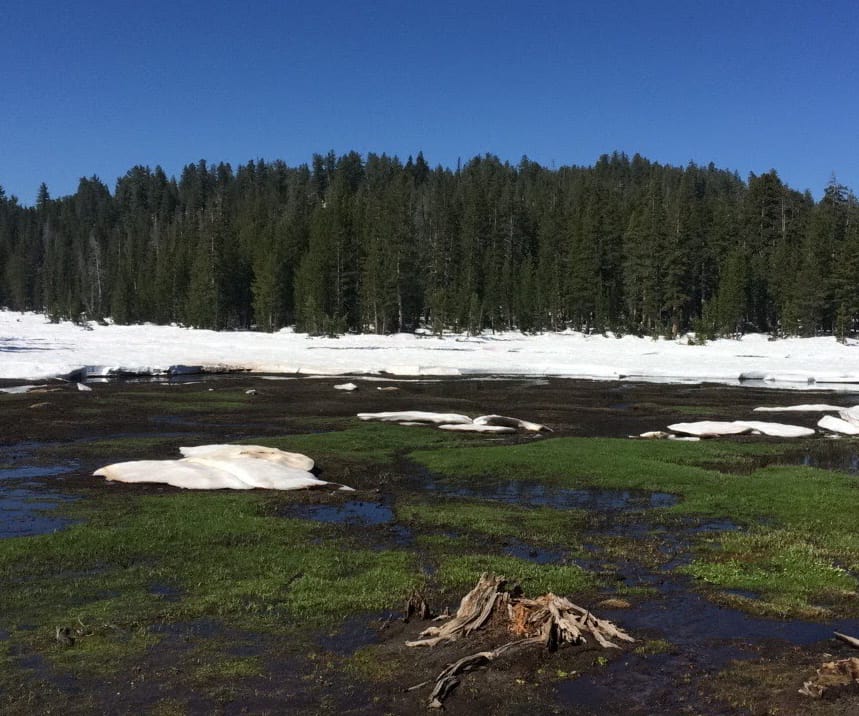Share this article
Site visit insights: Can captive rearing aid Yosemite toad?
Site visits are critical to helping scientists learn more about species and their habitats. The trips often take them into areas most people do not have a chance to explore, including public and privately-owned restricted sites, as well as some remote and hard-to-reach areas. “Site visit Insights” provides a behind-the-scenes perspective of wildlife biology, featuring photographs and interesting discoveries and happenings biologists experience in the field.
In cooperation with the U.S. Fish and Wildlife Service, The Wildlife Society is pleased to share these insights.
Wildlife Biologist: Ian Vogel, wildlife biologist, Sacramento Fish and Wildlife Office Sierra-Cascades Division
Site visit location: Sierra National Forest, Clovis, California
What was the purpose of the site visit?
Sacramento Fish and Wildlife Office biologists Sarah Markegard, Jill Seymour and I attended the site visit to assist with collecting Yosemite toad (Anaxyrus canorus) eggs for two different captive rearing projects. The Yosemite toad is a threatened species that occupies a small area at high elevations in the Sierra Nevada. We visited a meadow where the toad breeds as soon as the snow starts to melt.
One project was a pilot captive rearing study to determine whether or not tadpoles bred in captivity can survive and when released to the wild as healthy, robust adults. This will hopefully give the toads a better chance of survival in the wild.
The other project was a study to improve captive rearing practices for the Yosemite toad and to study the effects of drought and bacterial infection on the threatened species. This research will help us better understand threats to the species, including climate and how to better conserve the species.
Where did you go?
We visited a meadow on the Sierra National Forest in Fresno County, California. This meadow is over 9,000 feet in elevation.
What partners were you working with and what is the nature of SFWO’s partnership with them?
We attended the site visit with partners from the Sierra National Forest, Yosemite National Park and U.S. Geological Survey, as well as a graduate student from the University of Nevada, Reno. Because Yosemite National Park and University of Nevada, Reno were collecting eggs of a threatened species, both partners needed to obtain a permit from the U.S. Fish and Wildlife Service.
We assisted both partners in project design to ensure that these actions do not harm this population of Yosemite toads. We work with all four partners to help conserve many listed species by providing funding, assisting with recovery projects, minimizing impacts of land management practices and permitting.
What did you learn from this site visit that you didn’t know before?
While I’ve learned about Yosemite toads by reading literature and talking with species experts, seeing an active breeding meadow was a very educational and unforgettable experience. In addition to learning more about this unique species, we also learned about the difficult task of finding egg masses in the flooded meadow, the delicate process of collecting eggs and the nerve-wracking effort of transporting the eggs.
Egg masses blend in exceptionally well with the mud and vegetation in the meadow. Once a viable egg mass was found, one of our partners would very carefully collect a few eggs. The eggs were then carefully packaged in a cooler and transported to their captive rearing site. Seeing the breeding meadow and assisting with the egg collection will help us better understand Yosemite toads and what our partners are doing to conserve the species.
What surprises did you encounter during the site visit?
The biggest surprise from the site visit was how loud the meadow was. Normally, when we visit remote sites in the Sierra Nevada away from human activity, it is remarkably quiet except for singing birds. But not in a Yosemite toad breeding meadow. Male Yosemite toads make a trilling call to attract females. Pacific tree frogs were also breeding in the meadow; they also call to attract mates. There were so many well-camouflaged toads and frogs — some the size of a dime — that we had to watch our every step. Hundreds of amphibians trilling and hopping around made it seem like the meadow itself was alive.

Remote sites in the Sierra Nevada are typically very quiet, but in a Yosemite toad breeding meadow, there is a constant hum from mating calls. ©Ian Vogel, USFWS
The U.S Fish and Wildlife Service is a Strategic Partner of The Wildlife Society.
Header Image: Ian Vogel is a fish and wildlife biologist in the Sacramento Fish and Wildlife Office. ©Veronica Davison, USFWS








